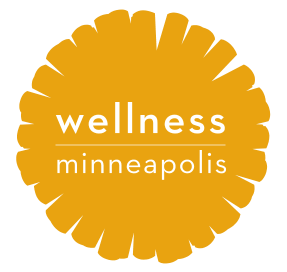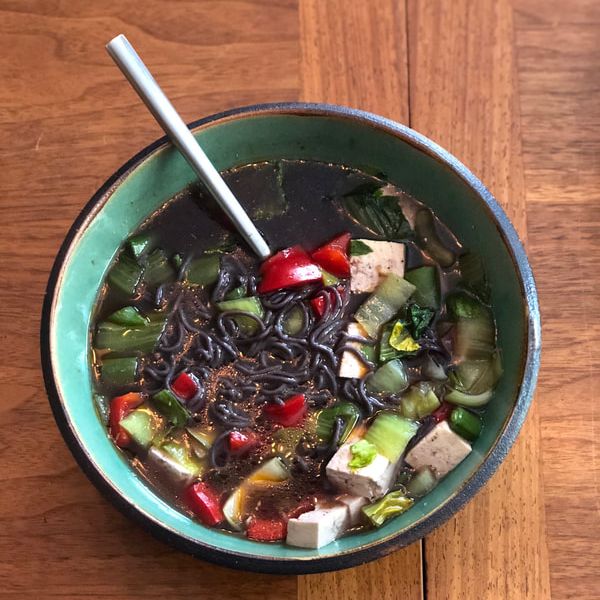From the kitchen of Jesse Haas, CNS, LN
I am a self-crowned queen of one-pot meals. They make my world go round.
Recently I've been jamming on a tofu and veggie noodle soup dish that has been hitting the spot for weeks.
Now, soy has gotten a bad rap over the years, that has largely been unresolved. Before you dig into the following rant about that, get you soup going - it will be ready by the time you finish reading this.
There are two big things about soy that come up in my work with clients and conversations with other wellness junkies:
1) Soy is an allergen. It is one of the 7 most common food allergens, and for that reason can be problematic for people. People who have an allergy to soy may experience difficulty breathing, hives, rapid heart rate, tightening in their throat or chest, and other not fun and potentially life threatening symptoms.
An intolerance to soy (or any other food) could be less straightforward. Food intolerances are sneaky, sneaky. Symptoms include digestive upset of all shapes and sizes, muscle and joint pain, headaches and migraines, brain fog, fatigue, eczema and much more fun. An Elimination Diet is the best way to identify food intolerances.
2) Compounds in soy have been named "phyto-estrogens" and implicated in various health concerns, including the obesity epidemic - especially a pattern of fat accumulation that had been identified as "feminine" (i.e. breasts, butt and thighs) - early puberty, breast and other cancers of the sex organs.
Years ago, I heard a retelling of a conversation with the biochemist who identified phytoestrogens in which he reported regret for the naming of the compound, because it raised some significant alarm and dissuaded individuals from eating soy. I mean, when hormones like estrogen are implicated in all kinds of diseases, who would want to eat it? (this is all hearsay so don't quote me on it)
Phytoestrogens were named such because they resemble the chemical structure of estradiol, an active form of estrogen. This molecular mimicry allows phytoestrogens to attach to estrogen receptors in the body and exert a similar effect. While they're able to bind to these receptors, they do so weakly thereby exerting a weaker effect than estradiol or other forms of estrogen. The consequence of this is that estradiol remains in circulation and is therefore shuttled to detoxification and elimination.
What does that mean for our health?
Well, it turns out that these compounds, a class of isoflavones, actually protect against those cancers we previously feared. If you want to read more about that, I recommend this article by Dr. Tina Kaczor who dug into the literature to better understand what the relationship between soy consumption and cancer actually was.
Bottom line: People who are allergic or have an intolerance to soy should not eat it. But if you're not allergic to soy, even if you have a family history of breast cancer, bon appetit.
One last note on soy foods before I give you this delicious recipe: not all soy foods are created equal.
Imagine a drive through the Minnesota countryside: on your left you see corn waving in the wind as far as your eye can see. And on your right, you see soy replenishing the corn-depleted soil from last years growing season. Combined, corn and soy make up 50% of all crops grown in the US. We are so good at growing corn and soy that food scientists had to figure out what to do with all of it, and now byproducts of each are in virtually every box, bag or can of food.
Recently I've been jamming on a tofu and veggie noodle soup dish that has been hitting the spot for weeks.
Now, soy has gotten a bad rap over the years, that has largely been unresolved. Before you dig into the following rant about that, get you soup going - it will be ready by the time you finish reading this.
There are two big things about soy that come up in my work with clients and conversations with other wellness junkies:
1) Soy is an allergen. It is one of the 7 most common food allergens, and for that reason can be problematic for people. People who have an allergy to soy may experience difficulty breathing, hives, rapid heart rate, tightening in their throat or chest, and other not fun and potentially life threatening symptoms.
An intolerance to soy (or any other food) could be less straightforward. Food intolerances are sneaky, sneaky. Symptoms include digestive upset of all shapes and sizes, muscle and joint pain, headaches and migraines, brain fog, fatigue, eczema and much more fun. An Elimination Diet is the best way to identify food intolerances.
2) Compounds in soy have been named "phyto-estrogens" and implicated in various health concerns, including the obesity epidemic - especially a pattern of fat accumulation that had been identified as "feminine" (i.e. breasts, butt and thighs) - early puberty, breast and other cancers of the sex organs.
Years ago, I heard a retelling of a conversation with the biochemist who identified phytoestrogens in which he reported regret for the naming of the compound, because it raised some significant alarm and dissuaded individuals from eating soy. I mean, when hormones like estrogen are implicated in all kinds of diseases, who would want to eat it? (this is all hearsay so don't quote me on it)
Phytoestrogens were named such because they resemble the chemical structure of estradiol, an active form of estrogen. This molecular mimicry allows phytoestrogens to attach to estrogen receptors in the body and exert a similar effect. While they're able to bind to these receptors, they do so weakly thereby exerting a weaker effect than estradiol or other forms of estrogen. The consequence of this is that estradiol remains in circulation and is therefore shuttled to detoxification and elimination.
What does that mean for our health?
Well, it turns out that these compounds, a class of isoflavones, actually protect against those cancers we previously feared. If you want to read more about that, I recommend this article by Dr. Tina Kaczor who dug into the literature to better understand what the relationship between soy consumption and cancer actually was.
Bottom line: People who are allergic or have an intolerance to soy should not eat it. But if you're not allergic to soy, even if you have a family history of breast cancer, bon appetit.
One last note on soy foods before I give you this delicious recipe: not all soy foods are created equal.
Imagine a drive through the Minnesota countryside: on your left you see corn waving in the wind as far as your eye can see. And on your right, you see soy replenishing the corn-depleted soil from last years growing season. Combined, corn and soy make up 50% of all crops grown in the US. We are so good at growing corn and soy that food scientists had to figure out what to do with all of it, and now byproducts of each are in virtually every box, bag or can of food.
| Ingredients made from SOY:
| Ingredients made from CORN:
|
If you read Dr. Kaczor's article, she'll make a case for including soy no matter the source. I have a little more conservative approach. When advising clients about choosing the foods with the highest nutritional value, I recommend limiting soy consumption to the whole food and traditionally fermented products: edamame, fermented tofu, tempeh, tamari or soy sauce. If shopping for soy milk, choose a product with the fewest ingredients possible...which should be water, soybeans and maybe some salt.
Rant complete.
You ready for that recipe now?
This soup is best eaten freshly prepared. The noodles do not hold over well and will get unappealingly mushy if cooked and stored. Store your prepped ingredients separately for an easy to assemble meal.
INGREDIENTS for 4 servings:
- 12 cups chicken or veggie broth
- 1 package Lotus Foods* black rice noodles
- 1" ginger root
- 1 block fermented tofu (I like Wildwood*)
- 1 red bell pepper
- 1 cup snap peas
- 2 baby pak choy
- 4 shiitake mushrooms
- 1 scallion
- toasted sesame oil or chili infused toasted sesame oil
- tamari
- cilantro (optional)
DIRECTIONS:
- Bring your broth to a boil in large saucepan: 3 cups per serving.
- While your broth is heating, chop the tofu, bell pepper, snap peas, pok choy, mushrooms and scallions into small pieces.
- When your broth is ready, place 1 block of rice noodles per serving into the broth. Grate the ginger into the broth with a box grater. Cover and cook as directed. Portion out the cooked noodles to soup bowls. Give them a generous amount of toasted sesame or chili infused toasted sesame oil and toss so they don't stick to each other.
- Add approximately a 1/2 cup of tofu and pak choy, and a 1/4 cup bell pepper, snap peas, mushrooms and scallion to the pot (per serving). Cook for 3-5 minutes.
- Ladle broth and yummies over your noodles and season with tamari and cilantro, if using.
- Dig in with a fork or chopsticks and get ready to sip broth right from the bowl.
*I am not affiliated with these brands and do not make a commission on recommended their products to you.
| Jesse Haas, CNS, LN is a licensed functional nutritionist and certified health coach. She was a founding partner of Wellness Minneapolis and was an active practitioner with the clinic from 2014-2022. To connect with her regarding functional nutrition and health coaching services, please follow this link. |



 RSS Feed
RSS Feed